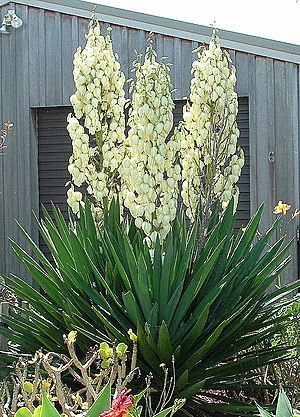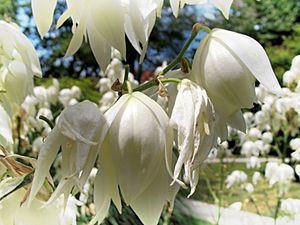Yucca filamentosa facts for kids
Quick facts for kids Yucca filamentosa |
|
|---|---|
 |
|
| Conservation status | |
| Scientific classification |
Yucca filamentosa, also known as Adam’s needle, is a type of flowering plant. It belongs to the Asparagaceae family. This plant naturally grows in the southeastern United States.
Adam's needle can grow up to 3 meters (about 10 feet) tall. It is an evergreen shrub, meaning it keeps its leaves all year round. People like to grow it in gardens because of its unique shape and look. It is closely related to another plant called Yucca flaccida. Some scientists think they might even be the same species.
Contents
What Are Its Names?
This plant has many interesting common names. Besides Adam's needle, people also call it:
- common yucca
- Spanish bayonet
- bear-grass
- needle-palm
- silk-grass
- spoon-leaf yucca
Discovering Adam's Needle: Plant Description
Adam's needle usually does not have a main trunk. Instead, it grows many shoots from its base. These shoots have heads of blue-green leaves that are about 75 cm (30 inches) long. The leaves are shaped like straps and have white, thread-like fibers along their edges. These threads help tell it apart from other yucca plants.
In early summer, tall flower stems grow up to 3 meters (about 10 feet) high. These stems hold many creamy, bell-shaped flowers that hang downwards.
How Yucca Plants Reproduce
Yucca flowers are pollinated by a special insect called the yucca moth (Tegeticula yuccasella). This moth helps the plant make seeds. Other types of moths, like Tegeticula intermedia, also use this yucca plant to lay their eggs. This is an important part of their life cycle.
Where Does Adam's Needle Grow?
Yucca filamentosa is found naturally in the southeastern United States. It grows from Virginia down to Florida and west into Texas. It has also started to grow in other places. You can find it along the Atlantic coast, as far north as Long Island Sound. It also grows in parts of the lower Midwest. This plant has even spread to countries like France, Italy, and Turkey.
You will most often see Adam's needle in sandy soils. It likes beach scrub areas and sand dunes. But it can also grow well in fields, open areas, and on rocky slopes. It can even grow in silt or clay soils.
Growing Adam's Needle in Your Garden
Many people grow Y. filamentosa in areas with mild weather. It is a fairly small plant but looks very striking. Its sword-like leaves and tall flower stalks make it stand out. It can be a great center point in a garden. It also adds a tropical feel to gardens in cooler areas.
This plant needs a lot of sunlight and soil that drains water well. It prefers soil that is a little bit acidic or slightly alkaline. This means a pH level between 5.5 and 7.5. It grows a large, thick, white taproot that goes deep into the ground. Once it is planted and settled, it can be hard to remove. Its roots will keep sending up new shoots for many years. It can survive cold temperatures down to about -29 degrees Celsius (-20 degrees Fahrenheit).
Special Types of Adam's Needle
Gardeners have developed different types of Adam's needle, called cultivars. These have special features:
- 'Bright Edge' is a smaller type. Its leaves have yellow edges, and its creamy flowers have a touch of green. It has won an award called the Royal Horticultural Society's Award of Garden Merit.
- 'Color Guard' also won this award. Its leaves have wide yellow stripes all year. In winter, these stripes turn red.
Other popular types include:
- 'Golden Sword' - This one is similar to 'Bright Edge' but grows larger.
- 'Ivory Tower' - This type has creamy white flowers with a hint of green.
How People Use Adam's Needle
The fruits of the plant can be cooked and eaten after the seeds are taken out. The large flower petals can also be added to salads.
The leaves, stems, and roots of this plant have been used by people in the past. For example, the Cherokee people used parts of this plant to help catch fish.
See also
 In Spanish: Iczotl para niños
In Spanish: Iczotl para niños



